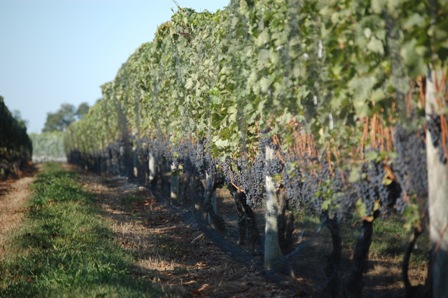|
Bordeaux Red Wine Many Aspire to Achieve it's Greatness A Bordeaux wine is any wine produced in the Bordeaux region of France. Average vintages produce over 700 million bottles of Bordeaux wine, ranging from large quantities of everyday table wine, to some of the most expensive and prestigious wines in the world. 89% of wine produced in Bordeaux is red wine called "claret" in Britain.
Although domestically popular, French wine was seldom exported, as the area covered by vineyards and the volume of wine produced were low. In the 12th century however, the popularity of Bordeaux wines increased dramatically following the marriage of Henry Plantagenet and Aliénor d’Aquitaine. The marriage made the province of Aquitaine English territory, and thenceforth the majority of Bordeaux was exported This accounts for the ubiquity of claret in England. As the popularity of Bordeaux wine increased, the vineyards expanded to accommodate the demands from abroad. Being the land tax beneficiary, Henry II was in favor of this industry, and to increase it further, abolished export taxes to England from the Aquitaine region. In the 13th and 14th century, a code of business practices called the police des vins emerged to give Bordeaux wine a distinct trade advantage over its neighboring regions. The export of Bordeaux was effectively halted by the outbreak of The Hundred Years' War between France and England in 1337. By the end of the conflict in 1453 France had repossessed the province, thus taking control of wine production in the region. In 1725, the spread of vineyards throughout Bordeaux was so vast that it was divided into specific areas so that the consumer could tell exactly where each wine was from. The collection of districts was known as the Vignoble de Bordeaux, and bottles were labeled with both the region and the area from which they originated. From 1875-1892 almost all Bordeaux vineyards were ruined by Phylloxera infestations. The region's wine industry was rescued by grafting native vines on to pest-resistant American rootstock and all Bordeaux vines that survive to this day are a product of this action. This is not to say that all contemporary Bordeaux wines are truly American wines, as rootstock does not affect the production of grapes. Owing to the lucrative nature of this business, other areas in France began growing their own wines and labeling them as Bordeaux products. As profits in the Aquitaine region declined, the vignerons demanded that the government impose a law declaring that only produce from Bordeaux could be labeled with this name. The Institut National des Appellations d'Origine (INAO) was created for this purpose. In 1936, the government responded to the appeals from the winemakers and stated that all regions in France had to name their wines by the place in which they had been produced. Labeled with the AOC approved stamp, products were officially confirmed to be from the region that it stated. This law later extended to other goods such as cheese, poultry and vegetables. The economic problems in the 1970s, in the wake of the 1973 oil crisis marked a difficult period for Bordeaux. A series of scandals coincided with a commercial crisis in Bordeaux. The vintage of 1972 had been overpriced as was 1973 and 1974. And when the market crashed the négociants were stuck with overpriced wine that they could not sell. The early 1980s saw a new trend. Inheritance taxes were doubled in 1981 and on top of the crisis in the 1970s, many families found it increasingly difficult to hang on to their châteaux. Enter domestic and foreign insurance companies, banks and other corporate giants. Some of these companies were looking for a quick profit, others were in it as a long-term investment. But the 1980s decade wasn't all bad. It also saw more great vintages in a single decade than ever before and a new era in other respects. First, wine critics (rather than just official classifications) started to have an influence on demand and prices. Wine critic Robert M. Parker, Jr. reviewed the 1982 Bordeaux vintage as the most sumptuous vintage in decades. Not only was this a turning point for Bordeaux wine economically, it also represented the beginning of an American domination of the reviewing of wine, especially Bordeaux. The result was a broader appeal of Bordeaux wine where the presence of fruit became a much more important factor than previously.

Red Bordeaux, which is traditionally known as claret in the United Kingdom, is generally made from a blend of grapes. Permitted grapes are Cabernet Sauvignon, Cabernet Franc, Merlot, Petit Verdot, Malbec and Carménère. Today Malbec and Carmenere are rarely used, with Château Clerc Milon, a fifth growth Bordeaux, being one of the few to still retain Carménère vines. As a very broad generalization, Cabernet Sauvignon (Bordeaux's second-most planted grape variety) dominates the blend in red wines produced in the Médoc and the rest of the left bank of the Gironde estuary. Typical top-quality Chateaux blends are 70% Cabernet Sauvignon, 15% Cabernet Franc & 15% Merlot. This is typically referred to as the "Bordeaux Blend." Merlot (Bordeaux's most-planted grape variety) and to a lesser extent Cabernet Franc (Third most planted variety) tend to predominate in Saint-Émilion, Pomerol and the other right bank appellations. These Right Bank blends from top-quality Chateaux are typically 70% Merlot, 15% Cabernet Franc & 15% Cabernet Sauvignon.
|
Sign up for weekly Red Wine Reviews
CLICK HEREWe will send you the extremely popular Red-Wine-Home tasting terms when you sign-up.





